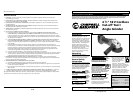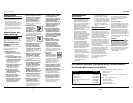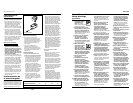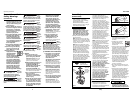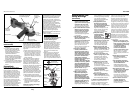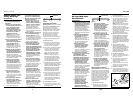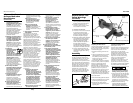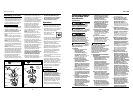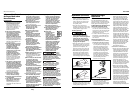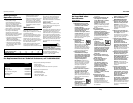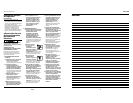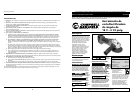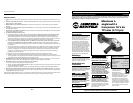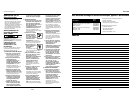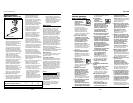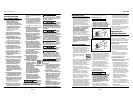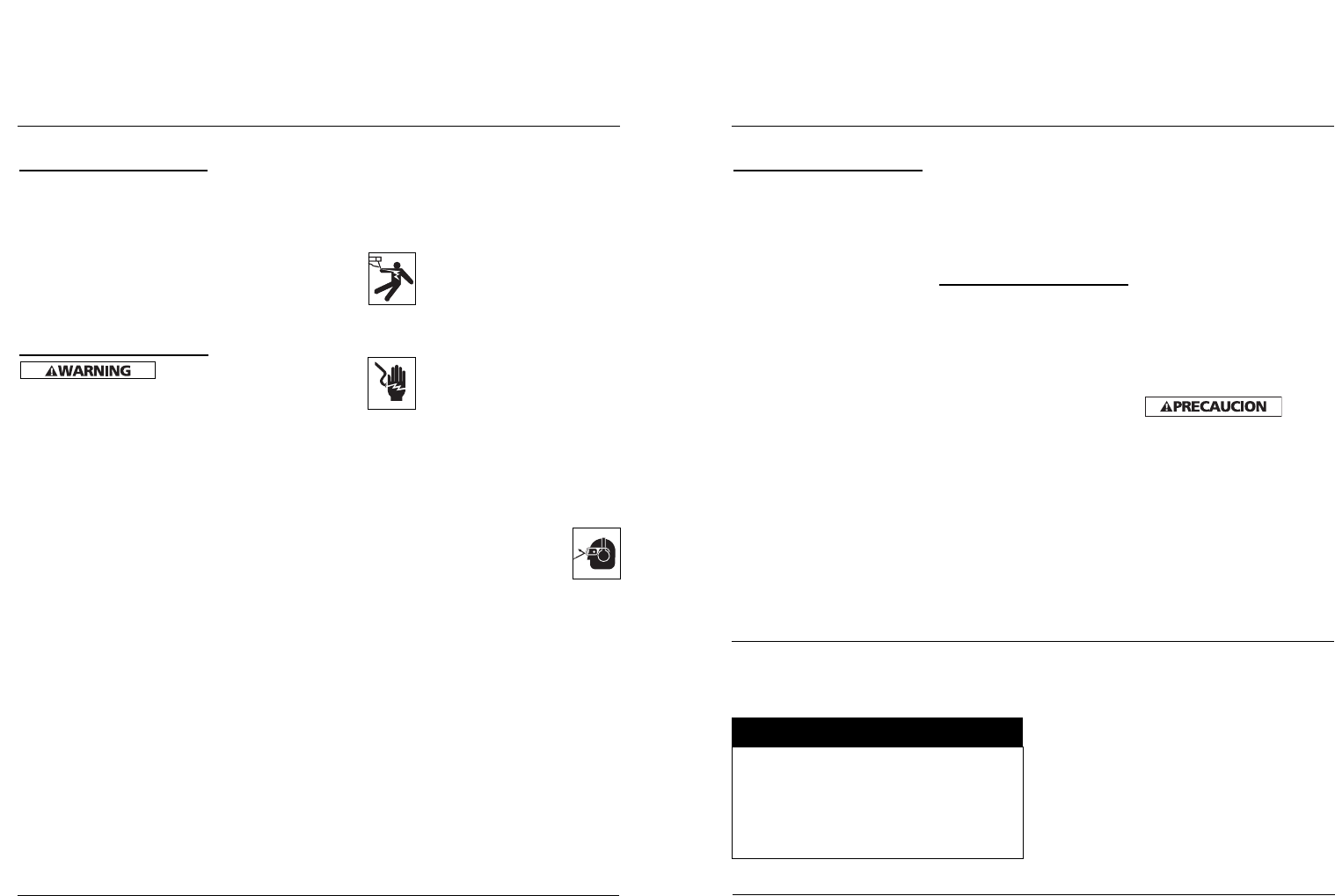
2.This power tool is intended to
function primarily as a cut-off tool or
a light-duty angle grinder.
Operations such as polishing, wire
brushing, and long-duty grinding are
not recommended with this power
tool. Operations for which the
power tool was not designed may
create a hazard and cause personal
injury.
General Power Tool
Safety Warnings
Read all
safety
warnings and all instructions. Failure to
follow the warnings and instructions may
result in electric shock, fire and/or serious
injury.
SAVE ALL WARNINGS AND
INSTRUCTIONS FOR FUTURE
REFERENCE.
The term “power tool” in the warnings
refers to your battery-operated
(cordless) power tool.
1) WORK AREA SAFETY
a) Keep work area clean and
well lit. Cluttered or dark areas
invite accidents.
b) Do not operate power tools in
explosive atmosphere, such as
in the presence of flammable
liquids, gases or dust. Power
tools create sparks which may
ignite the dust or fumes.
c) Keep children and bystanders
away while operating a
power tool. Distractions can
cause you to lose control.
d)Always work in a well-
ventilated area. Wear an
OSHA-approved dust mask
and safety glasses.
e)Use clamps or another
practical way to secure the
workpiece to a stable
platform. Never hold work in
your hand, lap, or against
other parts of your body
when using this tool.
2
Operating Instructions
2) ELECTRICAL SAFETY
a)Power tool plugs must match
the outlet. Never modify the
plug in any way. Do not use
any adapter plugs with
earthed (grounded) power
tools. Unmodified plugs and
matching outlets will reduce risk
of electric shock.
b)Avoid body contact
with earthed or
grounded surfaces,
such as pipes,
radiators, ranges and
refrigerators. There is an
increased risk of electric shock if
your body is earthed or grounded.
c)Do not expose power
tools to rain or wet
conditions. Water
entering a power tool
will increase the risk of
electric shock.
d)Do not abuse the cord. Never
use the cord for carrying,
pulling or unplugging the
power tool. Keep cord away
from heat, oil, sharp edges or
moving parts. Damaged or
entangled cords increase the risk
of electric shock.
e)When operating a power tool
outdoors, use an extension
cord suitable for outdoor
use. Use of a cord suitable for
outdoor use reduces the risk of
electric shock.
f)If operating a power tool in a
damp location is unavoidable,
use a ground fault circuit
interrupter (GFCI) protected
supply. Use of an GFCI reduces
the risk of electric shock.
g) Hold power tools by insulated
gripping surfaces when
performing an operation where
the cutting tool may contact
hidden wiring or its own cord.
Contact with a “live” wire will
make exposed metal parts of the
tool “live” and shock the operator.
h)Recharge the battery pack
only with the charger
supplied with this tool. A
charger that is suitable for one
type of battery pack may create
a risk of fire when used with
another battery pack.
i) Do not operate the battery
charger if its plug or cord has
been damaged. If these
components are damaged, have
them replaced immediately by
a qualified repair person.
j)Make sure the charger cord is
located so that it will not be
stepped on, tripped over, or
otherwise subjected to
damage or stress.
k) For optimal charging of the
battery pack, charging should
take place in temperatures
ranging from 32°F to 86°F [0°C
to 30°C]. Charging the battery
pack outside this recommended
range can adversely affect the
battery’s performance.
3) PERSONAL SAFETY
a)Stay alert, watch what you
are doing and use common
sense when operating a
power tool. Do not use a
power tool while you are
tired or under the influence of
drugs, alcohol or medication.
A moment of inattention while
operating power tools may result
in serious personal injury.
b)Use personal
protective
equipment. Always
wear eye protection.
Protective equipment
such as dust mask, non-skid
safety shoes, hard hat, or
hearing protection used for
appropriate conditions will
reduce personal injuries.
c)Prevent unintentional starting.
Ensure the switch is in the off-
position before connecting to
power source and/or battery
pack, picking up or carrying the
tool. Carrying power tools with
your finger on the switch or
energizing power tools that have
the switch on invites accidents.
d)Remove any adjusting key or
wrench before turning the
power tool on. A wrench or a
key left attached to a rotating
part of the power tool may
result in personal injury.
35 Sp
DG472500DI
Para Ordenar Repuestos o Asistencia Técnica, Sírvase Llamar al
Distribuidor Más Cercano a Su Domicilio
Sírvase proporcionar la información siguiente:
- Número del modelo
- Código impreso
- Descripción y número del repuesto según la lista de
repuestos
Número del
Descripción Repuesto
Dirija toda la correspondencia a:
Campbell Hausfeld
Attn: Parts Department
100 Production Drive
Harrison, OH 45030 U.S.A .
Disco de rectificado para metal de
10,16 cm (4.5") DG027700AV
Mango lateral DG027800AV
Llave de 2 dientes DG026600AV
Disco de corte de 4,5 pulg. (115 mm) DG030200AV
Batería – 18V DG472500AV
Cargador – 18V DG030100AV
antes de que llegue a este estado,
existe la posibilidad de que no se
optimice la capacidad/vida útil de la
batería. También es importante
tener en cuenta que una batería no
debe descargarse más que cuando
llega al estado de rendimiento
notorio mencionado anteriormente
ya que esto puede provocar un daño
irreversible en la batería.
• Para obtener el mejor rendimiento
de su batería, se recomienda
encarecidamente no dejar las
baterías en el cargador durante más
de 3 horas. Por lo tanto una vez que
alcancen su carga completa (que se
indica cuando se enciende la luz
verde en el cargador), es mejor
retirar la batería en ese momento o
en un momento próximo.
• No use un cable de extensión a
menos que sea absolutamente
necesario. El uso de un cable de
extensión inadecuado puede resultar
en un riesgo de incendio y choque
eléctrico. Si se debe usar un cable de
extensión, asegúrese de que:
– El tamaño del cable es al menos
el especificado en la tabla
llamada “Tamaño mínimo del
cable (AWG) de extensión para el
cargador de batería”.
– Que las clavijas del enchufe del
cable de extensión tengan el
mismo número, tamaño y forma
que las del enchufe de la
herramienta.
– Que el cable de extensión esté
correctamente cableado y en
buenas condiciones eléctricas.
– Si el cable de extensión va a usarse
en exteriores debe estar marcado
con el sufijo “W-A” o “W” después
de la designación del tipo de cable
para indicar que es apto para
usarse en exteriores. Por ejemplo:
SJTW-A
Mantenimiento
Limpieza
Antes de efectuar cualquier tarea de
limpieza, quite la batería de modo que
no haya riesgo de que la herramienta
se encienda accidentalmente.
Limpie el polvo y los desechos de los
orificios y contactos eléctricos,
soplando la herramienta con aire
comprimido. Mantenga los mangos de
las herramientas limpios, secos y libres
de aceite o grasa. Use únicamente un
jabón suave y un paño húmedo para
limpiar la herramienta, evitando todos
los contactos eléctricos.
Ciertos agentes de limpieza y solventes
son nocivos para los plásticos y otras
piezas aisladas. Algunos de éstos
incluyen gasolina, aguarrás, solvente
para laca, solvente de pintura,
solventes de limpieza con cloro,
amoníaco y detergentes de uso
doméstico que contengan amoníaco.
Nunca use solventes inflamables ni
combustibles cerca de las
herramientas.
La herramienta no funciona
En caso de que la herramienta no
funcione, asegúrese de que la batería
esté cargada e instalada en la
herramienta.
Servicio a la batería
La batería que se proporciona con este
herramienta se descargará sola y perderá
algo de su capacidad con el paso del
tiempo. Por lo tanto, si se almacena sin
usar durante un período de tiempo
prolongado, puede que sea necesario
recargarla antes de usarla. Para obtener
el mayor rendimiento de sus baterías, se
recomienda recargar la batería cada 2 ó 3
meses y cuando se recargue, se debe
retirar la batería del cargador después de
2 ó 3 horas de carga.
SERVICIO
El
servicio
de la herramienta debe ser realizado
sólo por personal de reparaciones
calificado. El servicio o mantenimiento
realizado por personas no calificadas
puede provocar riesgo de lesiones.
Para obtener información con relación
al funcionamiento o reparación de
este producto, sírvase llamar al
1-800-424-8936.
General Safety
Information (Continued)
Funcionamiento
(Continuacion)



